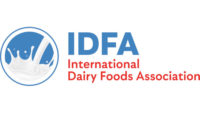A bipartisan group of more than 50 members of the U.S. House of Representatives today sent a letter to USDA Secretary Tom Vilsack urging USDA to address the underconsumption of dairy foods among American school-aged children. The group specifically requests making permanent a current flexibility that allows schools to offer low-fat flavored milk — a nutrient dense option for improving the quality of children’s diets according to the International Dairy Foods Association (IDFA) and National Milk Producers Federation (NMPF).
The letter cites the 2020 Dietary Guidelines Advisory Committee report, which found that 79% of 9- to 13-year-olds, who rely on the school meal programs to meet their nutritional needs, are not meeting the recommended intake of dairy foods. “Both the 2015 and 2020 editions of the Dietary Guidelines for Americans (DGAs) amplified this concern, stating that, beginning at a young age, average dairy consumption falls short of recommended amounts,” the letter states.
While current USDA flexibilities allow schools to offer low-fat flavored milk through the 2021-2022 school year, USDA has before it a proposed rule that would make these flexibilities permanent. Importantly, this action would remain consistent with the 2020-2025 Dietary Guidelines for Americans, IDFA and NMPF said.
“Milk, including low-fat flavored milk, is an important way for children to access the nutrient profile of dairy, providing 13 essential nutrients and unique health benefits,” said Michael Dykes, D.V.M., president and CEO of Washington, D.C.-based IDFA. “IDFA appreciates the leadership of the more than 50 champions for dairy in the House of Representatives for encouraging USDA to prioritize dairy in federal nutrition programs, specifically through the inclusion of low-fat flavored milk in school meal programs.
“Right now, USDA has before it a proposed rule that would return to flexibilities allowing flavored low-fat milk to be served in child nutrition programs, and IDFA strongly encourages the USDA to adopt school milk flexibility in the rule as a long-term solution,” he continued. “By doing so, the USDA would help ensure more kids meet the recommended intake for dairy set forth in the 2020-2025 Dietary Guidelines for Americans.”
Jim Mulhern, president and CEO of Arlington, Va.-based NMPF, noted that milk benefits children in many ways — assuming they drink it.
“It can’t benefit them at all if they don’t drink it, and ensuring that they do so requires a wide range of options,” he said. “Milk’s unique nutritional package is of great benefit to the nation’s schoolchildren, and this message to Secretary Vilsack strongly supports the critical goal of boosting consumption of essential nutrients of public health concern, including calcium, potassium and vitamin D.
“The 2020 Dietary Guidelines Advisory Committee report found that 79% of 9-13-year-olds, who rely on school meals to meet their nutritional needs, are not meeting the recommended intake of dairy foods,” he added. “Milk provides the foundation of a lifetime of better health, and we thank the signers of this letter, led by Reps. Courtney and Thompson, for recognizing and advancing its benefits.”



